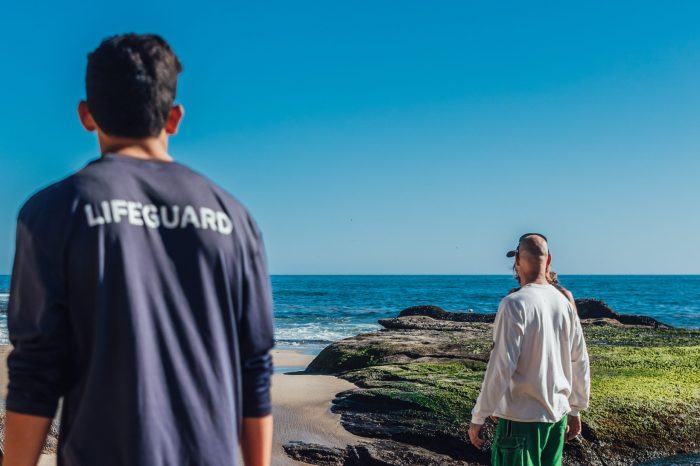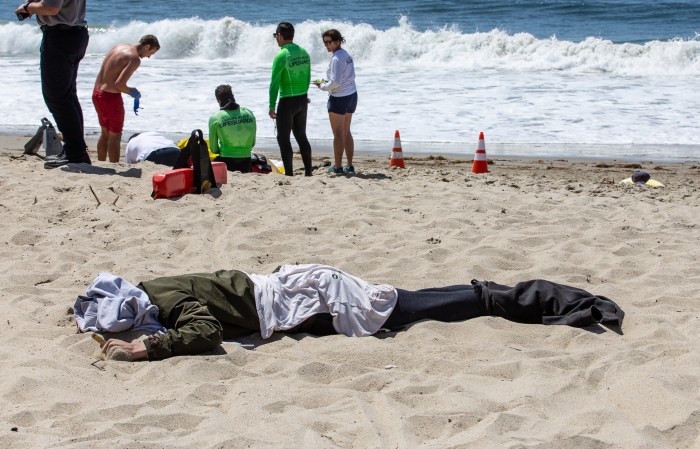Why do lifeguards wear red? This question has a fascinating answer that delves into the realm of visibility, safety, and cultural significance. Throughout history, the color red has played a crucial role in lifeguarding, and this article will explore the reasons behind its widespread adoption.
From its origins to its psychological impact, this article will shed light on the factors that have made red the go-to color for lifeguard uniforms worldwide.
Historical Context

Lifeguard uniforms have a rich history, with red emerging as the preferred color due to its high visibility and association with safety.
In the early days of lifeguarding, uniforms were not standardized, and lifeguards often wore whatever clothing was available. However, as the profession became more organized, the need for a recognizable and functional uniform became apparent.
Visibility and Safety
Red was chosen as the color for lifeguard uniforms primarily because of its high visibility. Red is a color that stands out in both natural and artificial light, making it easy to spot lifeguards in an emergency.
One of the reasons why lifeguards wear red is because it’s a highly visible color that can be easily spotted in an emergency. This is especially important in situations where time is of the essence, such as when someone is drowning.
Another reason why lifeguards wear red is because it’s a color that is associated with danger and urgency. This can help to deter people from swimming in areas where they shouldn’t be. Speaking of psychology, did you know that unit 7 ap psychology vocab is a great resource for learning about the different aspects of psychology? Anyways, getting back to lifeguards, the color red can also help to create a sense of authority and respect, which can be helpful in situations where lifeguards need to enforce the rules.
In addition, red has long been associated with safety and danger. The color is often used in warning signs and traffic signals, and it can help to create a sense of urgency and alert people to potential hazards.
Visibility and Safety

The color red stands out remarkably in both clear and murky water conditions. Scientific studies have demonstrated that red light has the longest wavelength and scatters less than other colors in water. This unique property makes red highly visible from a distance, enabling lifeguards to be easily spotted by swimmers in distress.
Enhanced Visibility in Various Water Conditions
- In clear water, red uniforms create a stark contrast against the blue or green background, making lifeguards highly visible from afar.
- In murky water, where visibility is reduced, red light penetrates better than other colors, allowing lifeguards to be seen more clearly.
Lifeguard Rescues Enabled by Red Uniforms
The high visibility of red uniforms has played a crucial role in numerous lifeguard rescues. Here are a few examples:
- In 2018, a lifeguard in Florida spotted a struggling swimmer from a distance thanks to his bright red uniform. The lifeguard was able to reach the swimmer in time and save their life.
- In 2020, a lifeguard in California used a red rescue tube to assist a swimmer who was being swept away by a strong current. The red tube provided high visibility, allowing the lifeguard to quickly locate and reach the swimmer.
Psychological Impact

Red holds significant psychological power, especially in emergency situations. Its vibrant hue triggers a cascade of reactions within individuals.
Firstly, red is associated with a sense of urgency. Its presence in our field of vision demands attention and evokes an immediate response. This makes it ideal for lifeguards, who need to act swiftly in emergencies.
Eliciting Alertness
Studies have shown that exposure to red increases alertness and vigilance. It stimulates the sympathetic nervous system, which prepares the body for action.
Inspiring Trust
Surprisingly, red can also inspire trust. It is often associated with authority and power, which can be reassuring in stressful situations. When lifeguards wear red, it conveys a sense of competence and trustworthiness, making beachgoers feel more at ease.
Cultural and Social Aspects

The association between lifeguards and the color red is deeply rooted in cultural and social factors. Red has historically been associated with danger, urgency, and attention, making it an ideal choice for lifeguarding uniforms.
Global Symbolism
Red has become a universally recognized symbol of lifeguarding. From the beaches of California to the shores of Australia, lifeguards don red uniforms to signal their presence and readiness to respond to emergencies. This color has become synonymous with water safety and has helped to create a global standard for lifeguarding practices.
Psychological Impact
Red is a highly visible color that can attract attention from a distance. This makes it an effective choice for lifeguards, who need to be easily spotted in emergency situations. Additionally, red has been shown to have a psychological impact on individuals, creating a sense of urgency and alertness.
This can help lifeguards to stay focused and react quickly to potential hazards.
Uniform Design
Lifeguard uniforms are specifically designed to enhance visibility and safety. They typically feature bright and contrasting colors, such as red, yellow, or orange, to make lifeguards easily identifiable in various conditions, including cloudy weather, murky water, or at night.
Reflective Materials
Many lifeguard uniforms incorporate reflective materials, such as stripes or patches, to increase visibility. These reflective elements bounce light back towards its source, making lifeguards more noticeable to boaters, swimmers, and other beachgoers. This is especially important in low-light conditions or when lifeguards are in the water.
Contrasting Colors, Why do lifeguards wear red
The use of contrasting colors on lifeguard uniforms helps to create a high level of visual contrast against the background, whether it’s water, sand, or a crowd of people. This contrast makes it easier for people to spot lifeguards from a distance, ensuring they can be located quickly in an emergency.
Exceptions and Variations
While red is the predominant color for lifeguard uniforms, there are a few exceptions to this norm.
One reason for these variations is environmental factors. For example, in some areas with dense vegetation or murky water, lifeguards may wear brighter colors like yellow or orange to increase their visibility.
Cultural Preferences
Cultural preferences can also play a role in lifeguard uniform color choices. In some countries, such as Australia, lifeguards traditionally wear yellow and red uniforms. This is believed to be because the Australian surf lifesaving movement was heavily influenced by British surf lifesavers, who wore yellow and red uniforms.
FAQs: Why Do Lifeguards Wear Red
Why is red the preferred color for lifeguard uniforms?
Red is highly visible in various water conditions, making lifeguards more easily identifiable in emergencies.
How does the color red impact individuals psychologically?
Red evokes a sense of urgency, alertness, and trust, which can be beneficial in emergency situations.
Are there any exceptions to the norm of red lifeguard uniforms?
In some cases, environmental factors or cultural preferences may lead to variations in lifeguard uniform colors, such as yellow or orange.